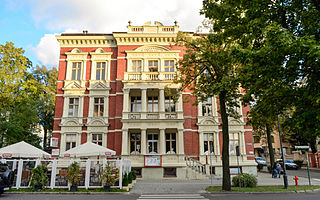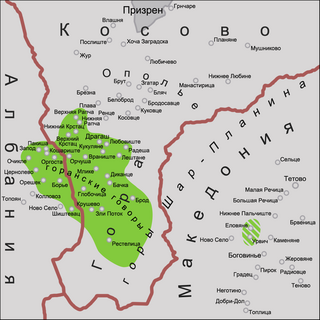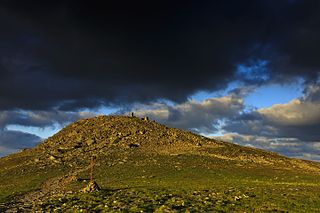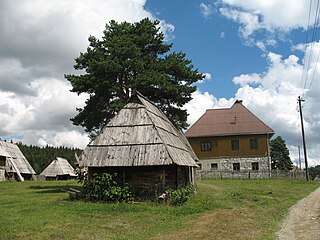
Zielona Góra is the largest city in Lubusz Voivodeship, located in western Poland, with 140,403 inhabitants (2021). The region is closely associated with vineyards and holds an annual Wine Fest. Zielona Góra is one of the two capital cities of Lubusz Voivodeship, hosting the province's elected assembly, while the seat of the centrally appointed governor is in the city of Gorzów Wielkopolski.

Lubusz Voivodeship is a voivodeship (province) in western Poland.

Kranjska Gora is a town in northwestern Slovenia, on the Sava Dolinka River in the Upper Carniola region, close to the Austrian and Italian borders. It is the seat of the Municipality of Kranjska Gora. The tripoint between Austria, Italy and Slovenia lies on the mountain of Dreiländereck, known as Peč in Slovenia.

The Gorani or Goranci, are a Slavic ethnic group inhabiting the Gora region—the triangle between Kosovo, Albania, and North Macedonia. They number an estimated 60,000 people, and speak a transitional South Slavic dialect, called Goranski. The vast majority of the Gorani people adhere to Sunni Islam.

Jelenia Góra is a historic city in southwestern Poland, within the historical region of Lower Silesia. Jelenia Góra is situated in the Lower Silesian Voivodeship, close to the Karkonosze mountain range running along the Polish-Czech border – ski resorts such as Karpacz and Szklarska Poręba are situated 10 to 15 kilometres from the city. Jelenia Góra constitutes a separate urban gmina as well as being the seat of surrounding Karkonosze County. In 2021 the population of Jelenia Góra was 77,366. The area, including the oldest spa district of Cieplice Śląskie-Zdrój, is one of the most valued recreational and leisure spots in Poland.

Zielona Góra County is a unit of territorial administration and local government (powiat) in Lubusz Voivodeship, western Poland. It came into being on January 1, 1999, as a result of the Polish local government reforms passed in 1998. Its administrative seat is the city of Zielona Góra, although the city is not part of the county. The county contains five towns: Sulechów, which lies 23 km (14 mi) north-east of Zielona Góra, Nowogród Bobrzański, which lies 25 km (16 mi) south-west of Zielona Góra, Babimost, which lies 40 km (25 mi) north-east of Zielona Góra, Czerwieńsk, which lies 11 km (7 mi) north-west of Zielona Góra, and Kargowa, 40 km (25 mi) north-east of Zielona Góra.

Fruška gora is a mountain in Syrmia, with most of the mountain being part of Serbia and its westernmost edge extending into eastern Croatia. The Serbian part of the mountain forms the country's oldest national park. Sometimes also referred to as the Jewel of Serbia, due to its largely pristine landscape and protection effort, or the Serbian Mount Athos, being the home of a large number of historical Serbian Orthodox monasteries.

Gora is a geographical region in southern Kosovo and northeastern Albania, primarily inhabited by the Gorani people. Due to geopolitical circumstances, some of the local Gorani people have over time also self declared themselves as Albanians, Macedonians, Bosniaks, Bulgarians, Serbs, Turks and Muslims by ethnicity.

Babia Góra National Park is one of the 23 national parks in Poland, located in the southern part of the country, in Lesser Poland Voivodeship, on the border with Slovakia. Its headquarters are located in Zawoja. A Nature Reserve which roughly covered the area of the modern-day national park was created in 1933, with the actual park established on October 30, 1954. Since 1976, it has been designated by UNESCO as a biosphere reserve.

Mokra Gora is a village located in the city of Užice, southwestern Serbia. It is situated on the northern slopes of the Zlatibor Mountains. Emphasis on historical reconstruction has made it into a popular tourist center with unique attractions.

The Šmarna Gora District, or simply Šmarna Gora, is a district of the City Municipality of Ljubljana, the capital of Slovenia. It has been named after Mount Saint Mary, an inselberg in the north of the city of Ljubljana.

Zastal Zielona Góra, officially Enea Zastal BC Zielona Góra for sponsorship reasons, is a Polish professional basketball team that is based in Zielona Góra, Poland. The team plays in the Polish League. For past club sponsorship names, see the list below.

Kamena Gora is a village in the municipality of Prijepolje, Serbia. According to the 2002 census, the village has a population of 210 people. It lies on the altitude between 800 and 1500 m on the eponymous mountain.

Strmna Gora is a village in the municipality of Valjevo, Serbia. According to the 2002 census, the village had a population of 166 people.

Mount Saint Mary, originally known as Holm, is an inselberg in the north of Ljubljana, the capital of Slovenia. The mountain is part of the city's Šmarna Gora District. It is the highest hill in the city and a popular hiking destination.

The Municipality of Kranjska Gora is a municipality on the Sava Dolinka River in the Upper Carniola region of northwest Slovenia, close to the Austrian and Italian borders. The seat of the municipality is the town of Kranjska Gora. It borders Italy & Austria.

Belaya Gora Airport is an airport serving the urban locality of Belaya Gora, Abyysky District, in the Sakha Republic of Russia. Provides regular flights to the regional center - Yakutsk, as well as flights within the region. The airport was opened in 1974.
Antusheva Gora is a rural locality in Moseyevskoye Rural Settlement, Totemsky District, Vologda Oblast, Russia. The population was 9 as of 2002.
Petrishcheva Gora is a rural locality in Moseyevskoye Rural Settlement, Totemsky District, Vologda Oblast, Russia. The population was 21 as of 2002.



















